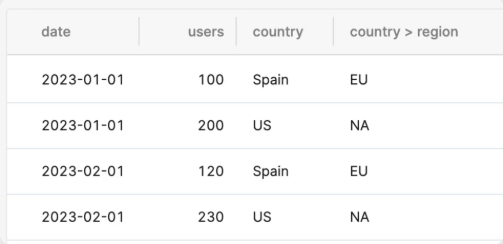Defining Database Queries
Last updated on 2025-11-07
Overview
Database queries are used to define which data is pulled in from your BI/Database system into xP&A. They are entered during the set-up process of the integration (see individual set-up instructions for each system) and need to be structured in a certain way.
In this chapter we explain how a database query is defined and what needs to be considered in regards to linked dimensions that are queried.
This article contains the following sections:
Defining a Query
Rules:
- A query starts with select.
- A query must return a date column.
- A query must return at least one value column for the variables (which can be numbers or dates).
- A query can return optional columns for dimensions, dimension mappings, or cohorts.
- Linked dimensions must be included in the following form `from dimension > to dimension` (using backticks)
For more details on linked dimensions, see Linking dimensions and the following chapter Limitations and Workarounds for Querying Linked Dimensions. - A query must contain from followed by the name of the table the data is to be extracted from.
Example query:
select date, users, country, region as "country > region" from users_table
Explanation:
- The data is queried from the users_table.
- The first column (date) has the dates of the transactions (timestamp or date type).
- The second column (users) contains the values of the "users" variable (number type).
- The third column (country) is a dimension column, the users are broken down by country (string).
- The fourth column (region as "country > region" ) is a dimension mapping. The region is not an independent dimension, but the countries are assigned to regions.
Example query result:
Querying Constant Values
If you only want to import constant values (no time series), the date column can be null. For example:
select null as date, price, plan_name from price_table
Limitations and Workarounds for Querying Linked Dimensions
When working with queries, you can only create one level of linked dimensions (mappings) per query. This means you can establish multiple direct relationships from a single source dimension, but you cannot create chained relationships within the same query.
Allowed in one query:
- A → B
- A → C
- A → D
Not allowed in one query:
- A → B and B → C simultaneously
Workaround Solution
To handle multi-level relationships, you need to create two separate queries:
Query 1: Define the initial mapping relationship
Query 2: Define the secondary mapping relationship using a fictional value
Example: Lease Contracts and Vehicle Types
Consider a scenario where:
- Lease contracts are tied to specific vehicles/license plate (A → B)
- Vehicles are linked to vehicle types (B → C)
- The relationship isn't always 1:1 due to vehicles appearing in multiple contracts
The following queries would be used:
Query 1: Lease Contract to License Plate Mapping
 Query 1
Query 1
Query 2: License Plate to Vehicle Type Mapping
Explanation:
- The second query uses a fictional value (in this case, 1) to satisfy query requirements which will not be used in any model.
- Both queries use null as date as a placeholder.
- The mapping syntax uses > to indicate the relationship direction.
- This approach maintains data integrity while working within the system's constraints.

